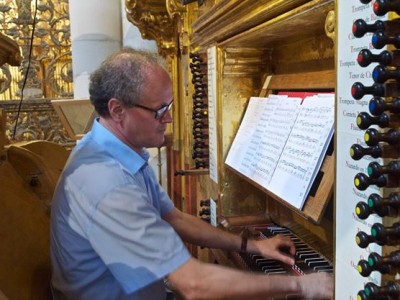by Daniel Hathaway

A late Renaissance instrument blown like a trumpet and fingered like a recorder, the cornetto is adept at doubling polyphonic vocal lines because of its penetrating tone, but is also perfect for playing florid melodic lines because it’s as agile as a violin. Dickey showed off the cornetto’s capabilities at the Covenant on Sunday afternoon, October 12, in his own “divisions” or elaborate variations on a chanson by Josquin des Prez and a motet by Palestrina. He also partnered masterfully with Tamminga in canzonas by Giovanni Maria Trabaci, Gioseffo Guami and Giovanni Gabrieli, playing the top line in these polyphonic works with a wonderful nobility of style.
Though the Oberlin and Covenant organs are tuned differently, each is set in a non-equal temperament, which allowed for some unusually consonant intervals as well as expressive dissonances. Designed after North German-style instruments, both are by nature more assertive than the gentle-sounding organs built in Italy during the late Renaissance. At times during Sunday’s recital, the cornetto got a bit lost in the texture of the organ’s foundation stops, something that rarely happened in the duo’s recent CD using a 16th century instrument in Bologna.
Tamminga gave Dickey some down time by interleaving colorful organ solos throughout the program. In Samuel Scheidt’s Bergamasca, he pitted the buzzy Dulcian stop against Trumpet and plenum. He played Gabrieli’s Canzon del 2o tono refreshingly on an octave-sounding flute, and used strikingly different stop combinations for each of the five variations in Sweelinck’s Ballo del granduca: reeds, flutes, the sesquialtera and the plenum all came into charming play.
Hearing fifteen short works on one program could seem like ticking items off a list, but Dickey and Tamminga worked a bit of subtle programming magic into the latter half of the concert. Palestrina’s sober motet, Nigra sum, formed a real contrast with the Sweelinck that preceded it, and Dickey’s divisions were elegant, playing with motives in echo style.
Then two merry Renaissance canzonas by Guami led to two tarantellas by baroque composers that closed the program. Santiago de Murcia’s 1714 Tarantelas for organ solo was a hauntingly repetitive Neapolitan dance. And though the Spaniard Gaetano Greco’s Tarantella con varie partite began so slowly that it might not have effected a cure, Dickey and Tamminga launched a thrilling accelerando at the end that surely danced the spider’s venom away.
Only three dozen listeners turned out on Sunday for the rare experience of hearing the cornetto live again. Such a niche event won’t draw hundreds of adoring fans, but a few more Clevelanders might have taken advantage of the opportunity to enjoy artistry of such high quality.
Published on ClevelandClassical.com October 14, 2014.
Click here for a printable copy of this article.




